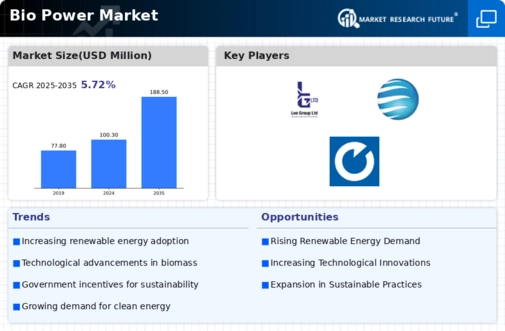Market Trends
Key Emerging Trends in the Bio Power Market
Bio Power Market, fueled by renewable energy sources like biomass, has seen dynamic market share positioning tactics. Companies in this market use numerous strategies to get a competitive edge. One strategy emphasizes technical innovation. Bioenergy production efficiency is improved by investing extensively in research and development, cutting costs and enhancing competitiveness. This draws eco-conscious customers and boosts the company's standing in a sustainable market.
Strategic agreements and collaborations are common among Bio Power industry companies. Companies may exchange knowledge, resources, and solve problems by creating partnerships. Collaborations may provide comprehensive and integrated bioenergy solutions for a wider market, increasing market share for all stakeholders. This method also helps organizations comply with regulations and expand.
Diversifying their product and service offerings helps Bio Power Market firms position themselves. This requires growing beyond biomass power generation into biogas, biofuels, and bio-based goods. Diversification helps organizations acquire value chain share and hedges against market uncertainty. Companies may continue development and market dominance by delivering a variety of bio-based solutions to varied consumers and sectors.
Geographic growth also matters for market share positioning. Companies look for places with good regulations, ample biomass, and rising energy needs. With a strategic presence in these sectors, organizations may enter new markets and acquire a competitive edge. This strategy boosts market share and aids the worldwide shift to renewable energy.
Customer-centric initiatives are crucial in the Bio Power Market. Understanding client preferences, organizations modify their offers to satisfy them. This may require unique bioenergy solutions for different businesses or variable pricing. A good customer experience builds brand loyalty and draws new customers, increasing market share.
Bio Power Market market share positioning techniques include efficient marketing and communication. Companies emphasize sustainability, environmental responsibility, and technology leadership to generate brand awareness. Transparent communication and education on bioenergy's advantages help consumers and stakeholders see it favorably. A favorable image boosts consumer trust and presents the firm as a bioenergy leader, increasing market share.
Finally, enterprises compete in the Bio Power Market through dynamic strategy interactions. Technological innovation, strategic collaborations, diversity, global growth, customer-centricity, and effective communication affect market share positioning. Companies who master and apply these tactics will prosper in the developing Bio Power Market as the worldwide focus on renewable energy grows.






Leave a Comment